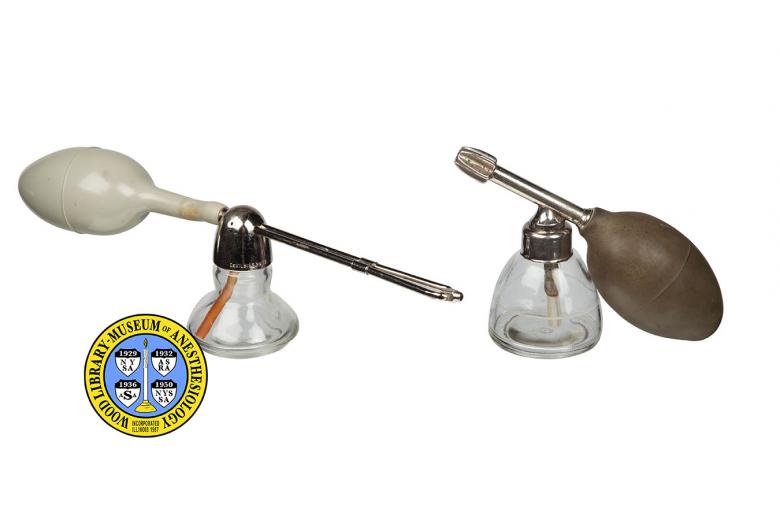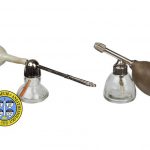DeVilbiss Atomizers
An atomizer is a device that allows for the application of a medication in a spray of tiny droplets. As an otolaryngologist, Dr. Allen De Vilbiss (1841-1917) of Toledo, Ohio, would have had many occasions in which he needed to apply a medication to a patient’s nasal cavities or throat. Dissatisfied with the available devices, he developed his first atomizer around 1887, and over a number of years added refinements and options for various needs. Dissolving the local anesthetic cocaine in an oil base to both numb and coat the nasal cavity and throat was a common treatment during Dr. De Vilbiss’ time, and so he made sure that his atomizers could convert warmed semi-liquids as well as liquids into a spray. The DeVilbiss atomizer quickly became a popular medical device, and in 1890 The DeVilbiss Manufacturing Company opened a factory to produce the atomizers in large numbers. Dr. De Vilbiss’ sons were also adept product developers, and within a few decades, the company was better known for producing atomizers for perfumes and spray guns for fine paint application.
The atomizer pictured on the left has a rotating nozzle at the tip, and the atomizer on the right is of the kind meant to administer medications in oil-based solutions. Although used much less often, DeVilbiss atomizers like these are still manufactured for the occasional procedure where a physician prefers an atomizer over more recently developed devices.
Catalog Record: DeVilbiss Atomizers
Two catalog records: akhf, akhg
Access Key: akhf
Accession No.: 2008-06-02-1 A W
Title: DeVilbiss no. 15.
Author: De Vilbiss, Allen, 1841-1917.
Corporate Author: DeVilbiss Company.
Title variation: Alt Title
Title: De Vilbiss no. 15.
Title variation: Alt Title
Title: DeVilbiss atomizer no. 15.
Title variation: Alt Title
Title: De Vilbiss atomizer no. 15.
Publisher: [Place of manufacture not indicated] : De Vilbiss, [1950-1980].
Physical Descript: 1 atomizer : glass, metal, plastic ; 7 x 5.5 x 26.5 cm.
Subject: Nebulizers and Vaporizers – instrumentation.
Subject: Anesthetics, Local – administration & dosage.
Subject: Anesthetics, Topical – administration & dosage.
Subject: Otolaryngology.
Note Type: General
Notes: Although the plastic bulb may not have been original to the atomizer, the
range of years for the possible year of manufacture begins with 1950, which
is when Plastisol was developed. The end year in the range, 1980, is based on
catalogs, publications and signs of wear to the atomizer. The date range
could change if documentation indicates the range should be corrected.
Note Type: General
Notes: Related archival collection: DeVilbiss corporation collection – MS 604.
Bowling Green State University Center for Archival Collections. https://www.
bgsu.edu/colleges/library/cac/ms/page45387.html. Accessed April 29, 2013.
Note Type: Citation
Notes: De Vilbiss A, inventor. Atomizer. US patent 378,357. February 21, 1888.
Note Type: Citation
Notes: De Vilbiss A, inventor. Atomizer. US patent 648,656. May 1, 1900.
Note Type: Citation
Notes: De Vilbiss A, inventor. Spray producing point for atomizers. US patent 842,
390. January 29, 1907.
Note Type: Citation
Notes: De Vilbiss A. The manner and necessity of topical applications to the
respiratory tract. Cincinnati Med Dent. 1887;3(1):1-6.
Note Type: Citation
Notes: De Vilbiss A. The treatment of acute and chronic rhinitis. Clevel Med Gaz.
1887;2(6):195-201.
Note Type: Citation
Notes: Dr. Allen De Vilbiss [obituaries]. NARD J. 1917;25(4):156.
Note Type: Physical Description
Notes: One atomizer with a bell shaped glass reservoir or bottle; A threaded metal
cap screws onto the glass bottle; The cap is the shape of a vertically
stretched dome; A discolored plastic tube extends from underneath the cap
down into the bottle; Two metal tubes approximately, 11.5 cm in length,
extend approximately 2 mm from one another from one side of the dome shaped
cap; The two tubes are connected at the end by a rotating spray nozzle; A
metal port approximately .8 cm in length extend from the other side of the
cap; Fitted snugly onto the port is a light gray plastic bulb; The bulb
measures approximately 7 cm in length and 5 cm in diameter when measured in
the middle; The plastic tubing connecting the bulb to the port measures
approximately 4.5 cm in length. Engraved into the side of the metal cap is
the following text, “De VILBISS No. 15”; On the bottom of the glass jar is
embossed, “11”.
Note Type: Reproduction
Notes: Photographed by Mr. Steve Donisch on January 15, 2013; Photographed with a no
45 DeVilbiss atomizer.
Note Type: Acquisition
Notes: Donated to the WLM by Vijayalkshmi U. Patil, MD.
Note Type: Historical
Notes: An atomizer is a device that allows for the application of a medication in a
spray of tiny droplets. As an otolaryngologist, Dr. Allen De Vilbiss
(1841-1917), of Toledo, Ohio, would have had many occasions in which he
needed to apply a medication to a patient’s nasal cavities, throat or parts
of the airway such as the larynx. Dissatisfied with the available devices, Dr
De Vilbiss developed his first atomizer around 1887, and over a number of
years added refinements and options for various needs. The tips of some of
his atomizers could be rotated to spray in several different directions, so
that with just a twist of the nozzle the user could spray up toward the post
nasal area, straight back toward the throat, or downward toward the larynx.
The atomizer described here is of the kind with a rotating nozzle. Dissolving
the local anesthetic cocaine with vaseline or an oil base to both numb and
coat the nasal cavity and throat was a common treatment during Dr. De
Vilbiss’ time, and so he made sure that his atomizers could convert warmed
semi-liquids as well as liquids into a spray. The atomizer became a popular
medical device and in 1890 the company he formed, The DeVilbiss Manufacturing
Company, opened a factory to produce the atomizers in large numbers. Dr. De
Vilbiss’ sons were also adept product developers and entrepreneurs, and
within a few decades, the company was better known for producing atomizers
for perfumes and spray guns for fine paint application.
Note Type: Historical
Notes: Sometime before or during 1926 the company’s name was change to The DeVilbiss
Company, and in 1951 the division that produced atomizers moved to Somerset,
Pennsylvania. Although used much less often, DeVilbiss atomizers, like the
one described here, are still manufactured for the occasional procedure where
a physician prefers an atomizer over more recently developed devices.
Note Type: Exhibition
Notes: Selected for the WLM website.
Access Key: akhg
Accession No.: 2001-05-07-1 B
Title: DeVilbiss no. 45.
Corporate Author: DeVilbiss Company.
Title variation: Alt Title
Title: De Vilbiss atomizer no. 45.
Publisher: Toledo, [Ohio] : DeVilbiss, [1930-1951].
Physical Descript: 1 atomizer : glass, metal, rubber ; 9 cm x 5.5 x 12.5 cm
Subject: Nebulizers and Vaporizers – instrumentation.
Subject: Anesthetics, Local – administration & dosage.
Subject: Anesthetics, Topical – administration & dosage.
Subject: Otolaryngology.
Note Type: General
Notes: The first year in the date range (1930) is based on the dates of publications
in which the atomizer was found. The end date is based on the year the
company moved from Toledo, Ohio to Somerset, Pennsylvania. The date range
could change if documentation indicates the range should be corrected.
Note Type: General
Notes: Related archival collection: DeVilbiss corporation collection – MS 604.
Bowling Green State University Center for Archival Collections. https://www.
bgsu.edu/colleges/library/cac/ms/page45387.html. Accessed April 29, 2013.
Note Type: Not Applicable
Notes: Catalogue of Surgical Instruments of Superior Quality. New York, NY: Herbert
F. Nusbaum; 1935:465.
Note Type: Citation
Notes: De Vilbiss A, inventor. Atomizer. US patent 378,357. February 21, 1888.
Note Type: Citation
Notes: De Vilbiss A, inventor. Atomizer. US patent 648,656. May 1, 1900.
Note Type: Citation
Notes: De Vilbiss A, inventor. Spray producing point for atomizers. US patent 842,
390. January 29, 1907.
Note Type: Citation
Notes: De Vilbiss A. The manner and necessity of topical applications to the
respiratory tract. Cincinnati Med Dent. 1887;3(1):1-6.
Note Type: Citation
Notes: De Vilbiss A. The treatment of acute and chronic rhinitis. Clevel Med Gaz.
1887;2(6):195-201.
Note Type: Citation
Notes: Dr. Allen De Vilbiss [obituaries]. NARD J. 1917;25(4):156.
Note Type: Physical Description
Notes: One atomizer with a glass reservoir or bottle, and a threaded metal cap which
screws onto the top of the glass bottle; The bottle is wider at the bottom
and tappers toward the top, measuring approximately 5.2 cm diameter at the
bottom and 2.2 cm diameter at the top; The metal cap is cylindrical and a
metal tube is affixed to the top of the cap at approximately a 45 degree
angle; The metal tube measures approximately 6.4 cm in length from the nozzle
tip to the other end, which is connected to a thick rubber bulb; The exterior
of the nozzle tip has five ribs that run approximately 1.7 cm longitudinally;
The ‘ribs’ gently taper to the nozzles tip; The bulb is made of thick rubber
that is dark green in color; The bulb measures approximately 7.7 cm in length
and 4.2 cm in diameter; In very small lettering, the following is engraved on
the cap, “DeVILBISS No. 45, TOLEDO, U.S.A.”; Also engraved on the cap is,
“MADE IN U.S.A.”.
Note Type: Reproduction
Notes: Photographed by Mr. Steve Donisch on January 15, 2013; Photographed with a no
15 DeVilbiss atomizer.
Note Type: Historical
Notes: An atomizer is a device that allows for the application of a medication in a
spray of tiny droplets. As an otolaryngologist, Dr. Allen De Vilbiss
(1841-1917), of Toledo, Ohio, would have had many occasions in which he
needed to apply a medication to a patient’s nasal cavities, throat or parts
of the airway such as the larynx. Dissatisfied with the available devices, Dr
De Vilbiss developed his first atomizer around 1887, and over a number of
years added refinements and options for various needs. The tips of some of
his atomizers could be rotated to spray in several different directions, so
that with just a twist of the nozzle the user could spray up toward the post
nasal area, straight back toward the throat, or downward toward the larynx.
Dissolving the local anesthetic cocaine with vaseline or an oil base to both
numb and coat the nasal cavity and throat was a common treatment during Dr.
De Vilbiss’ time, and so he made sure that his atomizers could convert warmed
semi-liquids as well as liquids into a spray. The atomizer became a popular
medical device and in 1890 the company he formed, The DeVilbiss Manufacturing
Company, opened a factory to produce the atomizers in large numbers. Dr. De
Vilbiss’ sons were also adept product developers and entrepreneurs, and
within a few decades, the company was better known for producing atomizers
for perfumes and spray guns for fine paint application.
Note Type: Historical
Notes: The atomizer described here is of the kind meant to apply oils or oil based
solutions.
Note Type: Historical
Notes: Sometime before or during 1926 the company’s name was change to The DeVilbiss
Company, and in 1951 the division that produced atomizers moved to Somerset,
Pennsylvania. Although used much less often, DeVilbiss atomizers, like the
one described here, are still manufactured for the occasional procedure where
a physician prefers an atomizer over more recently developed devices.
Note Type: Exhibition
Notes: Selected for the WLM website.


